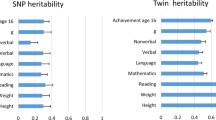Abstract
We compared twins with singletons in the National Epidemiological Child Psychiatric Study, which included 122 twins and 5455 singletons, born in 1981 and selected at random. Behavioural and emotional symptoms were assessed in 1989 on the basis of questionnaires filled in by the parents (Rutter Parent Questionnaire) (RA2), teachers (Rutter Teacher Questionnaire) (RB2) and the children themselves (Children’s Depression Inventory) (CDI). Parents’ reported proportions of probable behavioural/emotional disorders did not differ between the twin and singleton girls, but among the twin boys there was a nonsignificant trend of being more often probably disturbed. Twins were reported to be less disturbed than singletons according to the teachers’ assessments. No difference was found between twins and singletons in their self-reports. When analysing parents’ reported values of various sum scores, the twin boys obtained slightly higher scores than singletons, while twin girls scored significantly lower on total and emotional disturbances. Twin boys obtained lower mean scores than singletons for probable disorder in the teachers’ evaluations, the differences arising mostly in the emotional area. The same type of trend, however nonsignificant, was found among the teachers’ evaluations of girls. No significant difference was found in the mean scores for hyperactivity. This large population-based sample suggests that twins may have a lower rate of behavioural problems in childhood than singletons, a finding that has to be taken into account in behavioural genetic studies.
Similar content being viewed by others
References
Almqvist F, Ikäheimo K, Kumpulainen K, Tuompo-Johansson E, Linna SL, Puura K, Moilanen I, Räsänen E, Tamminen T, Piha J. Design and subjects of a Finnish epidemiological study on psychiatric disorders in childhood. European Child & Adolescent Psychiatry 8:Suppl. 1: (this supplement)
Dodd B, McEvoy S (1994) Twin language or phonological disorder. Journal of Child Language 21:273–289
Gau JS, Silberg JL, Erickson MT, Hewitt JK (1992) Childhood behaviour problems: a comparison of twin and non-twin samples. Acta Geneticae Medicae et Gemellologiae 41:53–63
Hay DA, Collett SM, Johnston CJ, O’Brien P, Prior M (1986) Do twins and singletons have the same language and reading problems? In: Pratt C, Garton AF, Turner WE, Nesdale AR (Eds) Research Issues in Child Development. Sydney: Allen & Urwin
Hay DA, Levy F, McStephen M, Rooney R (1998) Predictors of change in ADHD symptomatology in twins and their siblings: perspectives from the Australian twin ADHD project. (Abstract) Twin Research 1:92
Hay DA, O’Brien PJ (1987) Early influences on the school social adjustment of twins. Acta Geneticae Medicae et Gemellologiae 36:239–248
Hay DA, O’Brien PJ, Johnston CJ, Prior M (1984) The high incidence of reading disability in twin boys and its implications for genetic analysis. Acta Geneticae Medicae et Gemellologiae 33:223–236
Levy F, Hay D, McLaughlin M, Wood C, Waldman I (1996) Twin-sibling differences in parental reports of ADHD, speech, reading and behavioural problems. Journal of Child Psychology and Psychiatry 37:569–578
Macdonald AM, Bryan EM, Derom R, Hay D, Hebebrand J, Kirschbaum C, Kracke B, Pauls DL, Rowe DC, Rutter M (1993) Group report: what can twin studies contribute to the understanding of childhood behavioral disorders? In: Bouchard TJ, Propping P (Eds) Twins as a Tool of Behavior Genetics. Berlin: John Wiley and Sons
Mogford K (1988) Language Development in Exceptional Circumstances. London: Longman Group
Moilanen I (1987) Dominance and submissiveness between twins. II Consequences for mental health. Acta Geneticae Medicae et Gemellologiae 36:257–265
Moilanen I, Ebeling H (1998) To be born as a twin — risks and sequelae. International Journal of Circumpolar Health. 57:138–147
Paluzny M, Abelson AG (1975) Twins and child psychiatry. American Journal of Psychiatry 13:434–436
Robin M, Casati I (1994) Are twins different from singletons during early childhood? Early Development and Parenting 3:211–221
Rutter M, Redshaw J (1991) Annotation: Growing up as a twin: twin-singleton differences in psychological development. Journal of Child Psychology and Psychiatry 32:885–895
Rutter M, Simonoff E, Silberg J (1993) How informative are twin studies of child psychopathology? In: Bouchard TJ, Propping P (Eds) Twins as a Tool of Behaviour Genetics. Berlin: John Wiley and Sons
Van den Oord EJCG, Koot HM, Boomsma DI, Verhulst FC, Orlebeke JF (1995) A twin-singleton comparison of problem behaviour in 2–3-year-olds. Journal of Child Psychology and Psychiatry 36:449–458
Author information
Authors and Affiliations
Corresponding author
Rights and permissions
About this article
Cite this article
Moilanen, I., Linna, S.L., Ebeling, H. et al. Are twins’ behavioural/emotional problems different from singletons’?. European Child & Adolescent Psychiatry 8 (Suppl 4), S62–S67 (1999). https://doi.org/10.1007/PL00010702
Issue Date:
DOI: https://doi.org/10.1007/PL00010702




